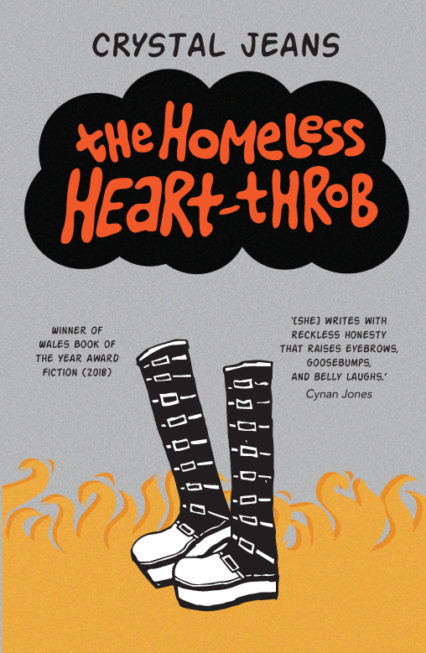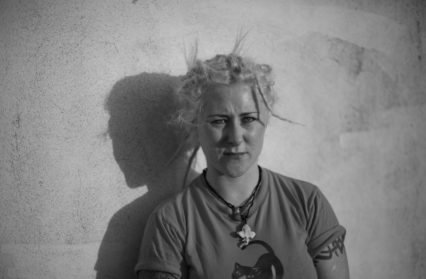Bethan James reviews the The Homeless Heart Throb, the follow up to Crystal Jeans’s award-winning novel, Light Switches Are My Kryptonite.
Monsterberry Crush, the titular character of The Homeless Heart-Throb, is a homeless man, suffering with alcoholism, who wanders the area around Tamerlane Road in Cardiff. His uniform is jeans and a leather jacket, and according to the narrator of one story, ‘Dirty. He looks really dirty.’We learn more about the complexity of his character than these initial impressions permit through those in the community that encounter him, though these people are always more than mere devices for an exposition of his character. The title’s suggestion of a single character’s centrality should not mislead; Crystal Jeans has crafted a community of characters where vastly different lives intersect unexpectedly, and a collection of stories in which the multifaceted nature of human relationships is demonstrated in the truest sense.
 In the acknowledgements Jeans thanks ‘all the real-life people whose characteristics and general auras’ she has drawn upon in this book. This is apparent within the first few pages as two friends discuss the crude diagrams of their teenage diaries, into which they poured frustrated and confused lust: ‘And it all went in the fucking diary. Every time my heart fluttered for him. Every wank, practically.’ This is not the typical speech of fiction, but the unfiltered candidness of ‘real-life people’, only normally revealed when they recede into trusted company or believe themselves unobserved.
In the acknowledgements Jeans thanks ‘all the real-life people whose characteristics and general auras’ she has drawn upon in this book. This is apparent within the first few pages as two friends discuss the crude diagrams of their teenage diaries, into which they poured frustrated and confused lust: ‘And it all went in the fucking diary. Every time my heart fluttered for him. Every wank, practically.’ This is not the typical speech of fiction, but the unfiltered candidness of ‘real-life people’, only normally revealed when they recede into trusted company or believe themselves unobserved.
In ‘The-I-Love-You-Jar’ (the story is not as cloyingly cutesy as its title suggests), Sez tries to reckon with his upbringing and the legacy it has on his current relationships: ‘Your mother was a nasty cow and you’ve been damaged and it’s not your fault. Boo fucking hoo.’ The story that immediately follows is from the perspective of his mother, and although it does not directly respond to the themes of Sez’s story, the pacing and placement of these stories, as throughout the collection, forces narratives into conversation.
Sez’s mum, Holly, is given a nuanced interior life and resilient constitution that is gradually revealed in a series of stories spaced throughout the collection. She works in a care home, and this, as well as a shattering event in her personal life that is at first indistinct but gradually clarifies to reveal her essential relationship with Monsterberry Crush, is what affords her character’s voice a realism that is warm and grounded. Holly’s stories range in date from 1995 to 2012 and Jeans does not privilege the reader to a continued, logical narrative of the character’s life; nor are the stories in chronological order, so that the details of Holly’s narrative sometimes risk becoming obscured, but to the advantage that her proximity to the titular character is revealed incrementally through centripetal orbits. Jeans’s stories are not interested in divulging whole, transparent, didactic truths but rather glimpses into the imperfect, often unresolved realm of human relationships.
Though this lack of temporal progression risks confusion at moments, it is overwhelmingly engaging technique, and encourages careful attention to the detailed characterisation of Jeans’ extensive cast of characters; for example, a character’s ‘frizzy red hair’ and choice of reading material are the only clues Jeans gives us that this character, who appears in an early story as an impatient, impertinent salon customer, will return in a later story in an entirely new role, enjoying erotic mastery over an older man who cleans and cooks for her, addressing her as ‘God’.
Elsewhere in the collection we encounter Deena, ‘a beautiful Indian woman with thick eyeliner and lots of piercings’ who drinks too much but reasons that she does this because she does ‘notwant to stop after just one drink,’ unlike her friend Dennis (whom we also briefly encounter) who had ‘been unableto.’ After Monsterberry Crush wanders into Deena’s family home and falls asleep on the sofa, her mother, Hatima,asks ‘Why are you always attracting the alcoholics, Deena?’ Alcohol addiction and abuse are central themes in this collection of stories. Jeans’ writing acknowledges the stereotypes around such a subject and swiftly overturns them; it demonstrates with tactful levity (“I seldom remember … I find it an advantageous by-product of alcohol abuse”) that alcoholism is not a person’s status, nor their choice, but often a response to the fragility of complex lives.
The story ‘Not so Manic Now’ is notable for the attention it devotes to a single character’s life over a period of years, especially the often private and internalised process of self definition. It is the story of a young woman, Lou, as she figures out her sexuality via a single night in Magaluf and a boyfriend whom she eventually concludes she is not ‘bisexual enough’ to date. But Lou’s story reaches out to encompass themes of self esteem and eating disorders and the narrative is robust enough to withstand cliche when Lou’s friend, Connie, emaciated and hospitalised, reminds her: ‘You have to … be kind to yourself.’
In the final story of the collection we learn that Monsterberry Crush’s real name is Dave; the revelation of this name is almost as underwhelming as the name itself, just a shift in the narrative from one name to another. This has the effect of destabilising every assumption we have been invited to make about his character: from the ‘homeless[ness]’ of the titular moniker to the liquor suggestive ‘Monsterberry Crush’, we are now face to face with Dave. But perhaps we knew this all along; perhaps all along Jeans has been revising the surety with which we attach preconceptions to a name, or an addiction, or the figure of a sleeping stranger slumped in a doorway.
It is a tender moment when, towards the end of The Homeless Heart-Throb, Holly turns to Dave and asks, ‘We’ve been through the wringer. Haven’t we da’ling?’ Indeed, they have. And yet, despite this, Dave emerges in the final paragraph of the collection dressed as Bryan Ferry, wearing black glasses, a black wig and a black suit jacket. He stands in a cemetery, ‘[swaying] his hips to the music and [smiling] wolfishly,’ he begins to sing. His performance is an act of kindness for a friend, and the image is a triumphant and joyful, blazing redemptive in the face of the loss and degradation he has suffered. Really, Crystal Jeans seems to say, people are capable of so much more than we might first expect.
The Homeless Heart Throb is available now from Honno.
You might also like…
Laura Wainwright delves into The Apartment, a “memorable and exciting” debut novel by Greg Baxter.
Bethan James is a contributor to Wales Arts Review.











